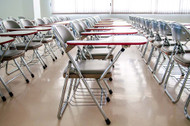Education floor spaces require some attention and focus. When designing the floor of the educational building, it is important to consider the impact of the floor on the students and other people. However, the construction side always fails to notice the classroom flooring due to cost restraints and other limitations. Classroom flooring is very important, as it reflects the attitude of the students towards education and shapes their learning xperience. The profound impact of the classroom floor on the student is massive.
In this article, we will highlight major factors that need to be considered by the building while constructing classroom floors due to their significance as learning attributes.
Creating a Positive Learning Environment
The classrooms are made for a learning environment and increase the learning capacity of the students. The learning environment is critical, and a well-designed classroom must promote learning proactively, making it comfortable and inviting. Flooring is one factor that contributes to the learning environment and shapes the experience in various ways. Some of the motivating factors are the following:
Comfort and Safety:
Comfort and safety are the prime reasons for a successful learning environment. The students spend a large amount of time in the classroom sitting. The floor they interact with should be comfortable and underfoot. A comfortable floor in the classroom means that it is non-slippery and resistant. The comfortable flooring indicates that students can walk and have direct contact with the floor. It promotes safety measures and cushions to reduce the risk of accidents and injuries.
Aesthetics Appeal
The aesthetic appeal of the classroom comes from the floor. It is the first thing that a person sees while entering the building. Aesthetic appeal greatly influences student learning due to the visually appealing floor and bright, cheerful, and engaging atmosphere. Educational spaces must inspire creativity and motivate students to explore. Having aesthetic appeal increases student motivation.
Acoustic Control:
Classrooms are bustling with students. Classroom space needs acoustic control to increase concentration and learning. Sound-absorbing flooring reduces noise levels, and it is easier for the student to concentrate on the communicated material effectively.
Design and layout considerations
It is also identified that classrooms must be designed and laid out with strategic guidance. The design of the classroom floor indicates student behaviour and engagement. Thus, a few points allow the classroom floor to assist in the learning process in a much better and faster way.
- Using different colours and patterns in the classroom assists in identifying the spaces for different activities. For instance, a reading corner with the right flooring can inspire reading habits in students. Wrong flooring can lead people to assume the reading corner is playground space. The distinction through colours can signal students and the purpose of the space effectively.
- Most of the time, students are clueless about where to go and how to proceed forward when there is no one to guide them. Having directional cues on the floor acts as a guiding tool for the students and increases their confidence.
- Flexibility and adaptability are the major factors that increase flexibility in the minds of students. The educational methods and classroom need to evolve in a much more flexible way to make them better.
Other Benefits of Classroom Flooring on Learning
Here are other key benefits of classroom flooring on learning, presented in concise points:
- Use of colors and patterns helps students navigate the classroom and understand space purposes.
- Directional Cues: Incorporating visual guides on the floor helps students orient themselves. Clear pathways boost confidence and encourage independent movement.
- Flexibility and Adaptability: Versatile flooring supports various learning styles and teaching methods. Adaptable spaces foster a dynamic educational environment, accommodating diverse activities.
- Promotes Engagement: Engaging floor designs can enhance interaction and participation. A well-considered flooring choice can stimulate interest and enthusiasm among students.
Selecting the right classroom flooring is crucial for creating a positive learning environment. It directly impacts student comfort, engagement, and overall educational experience, enabling students to reach their full potential.
Conclusion
Classroom flooring is integral to creating a conductive learning environment. It influences the student's comfort and focus on the learning experience. Through choosing the right flooring for the classroom, educational activities and institutions can be made to foster a greater learning experience. Students can reach their full potential in the classroom.
